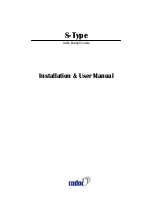
Front panel
1.
Bass
- This control adjusts the bass level of the channel. Turning the dial clockwise will increase the bass level, turning the dial anticlockwise
will reduce the bass level.
2.
Treble
- This control adjusts the treble level of the channel. Turning the dial clockwise will increase the treble level, turning the dial
anticlockwise will reduce the treble level.
3.
Level
- This control adjusts the gain/volume level of the individual channel.
4.
Mic Input
(balanced) - this microphone input accepts XLR-type connectors for low impedance microphones.
5.
Mic/Line Input
- These inputs can be connected to guitars, synthesizers, drum machines, CD players, etc. Please note this is a MONO input
source, if stereo is required you would need to spread the left and right signal over two separate channels, e.g. plug the left signal into channel 1
and the right signal into channel 2. Important only use mono jacks.
6.
Effect
- This knob controls the signal level which will be sent to the built-in digital delay effect.
7.
Line Input
- This dual input accepts RCA type connectors for stereo line level devices. You can use both the microphone and line input
simultaneously on channel 4.
8.
EQ
- The signal from the input channels, processed by the built-in three band equaliser feeds to the master output. There are three knobs
here to control the equalisation. Treble - This adjusts the high frequency range of the sound. Middle - This adjusts the middle range of the
sound. Bass - This adjusts the low frequency range of the sound.
9.
CD/Tape In
- This control adjusts the master volume of a line level input such as CD. The connection is via RCA/phono sockets on the rear
panel of the unit.
10.
Effect
- This adjusts the output level of the digital delay effects.
11.
Repeat
- This increases the rate of the delay. If you turn this knob to the right - you will hear the signal repeat at a faster rate.
12.
Time
- This adjusts the time interval of the delay, turn to the right to increase the time interval between the delay.
13.
Master
- This adjusts the final level of the main master output.
14.
USB/SD Digital Player
-
A. Play/Pause
B. Stop
C. Volume increase
D. Volume decrease
E. Track Skip backwards (holding this button will scan the track in reverse)
F. Track Skip forward (holding this button will scan the track forward)
G. Repeat - pressing once will repeat a single track over and over. Press again to repeat all the tracks on the USB or SD card after the whole
track selection has been played once.
H. EQ this button has 8 steps, and each step has a different preset EQ level. Pressing the button once will move the function forward one step.
The display shows E1-E8. Adjust this to your required sound taste. This EQ only affects the sound on the USB or SD card input.
I. SD/USB input selector
15. SD card slot
16. USB input socket
Rear Panel
17.
Power
- mains power on/off switch.
18.
Mains Input
- 240v AC.
19.
Fuse
- only replace the fuse with the correct value and rating (T1.6 amp).
20.
Line In
- mono line level input (there is no volume level control via this input).
21.
Line Out
- mono line level output (level controlled by master volume) connect to an external amp.
22.
Record Output
– left and right RCA/phono sockets. Connect to the input of a recording device.
23.
CD/Tape Input
- line level input (volume controlled by CD/Tape volume on front panel).
24.
Speakers
- main master output sockets. Connect passive speakers to these sockets (NOTE: minimum of 4 Ohm load). Only one 8 Ohm
speaker to be connected to each output socket.






















